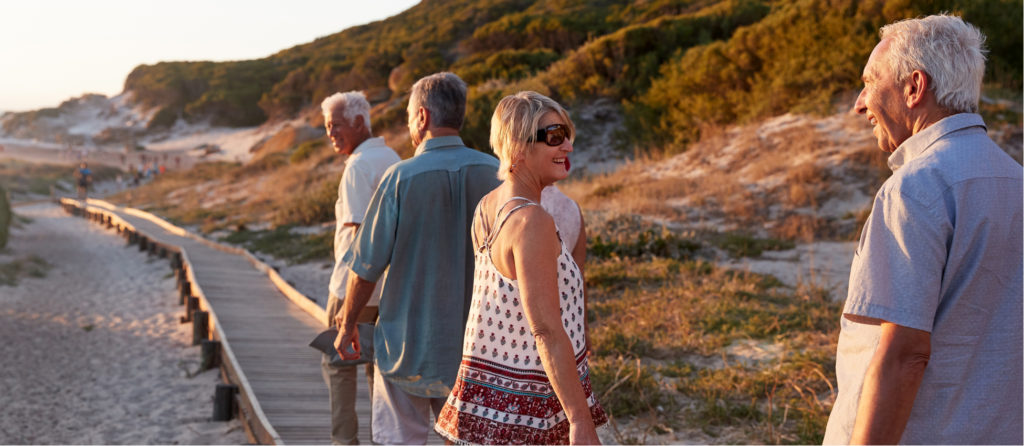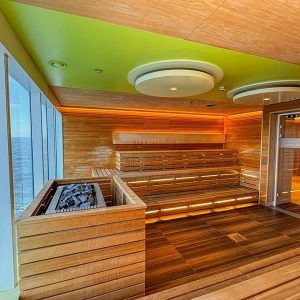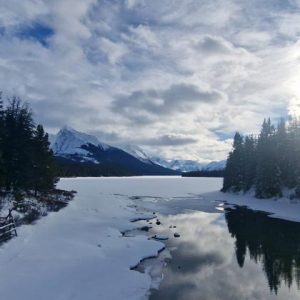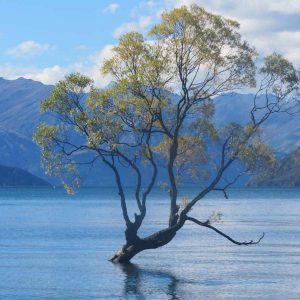Jennifer was selected to be a “tester” and to travel around Europe with a Global InterRail pass, keeping a diary of her travel and thoughts. She has shared these for Silver Travel Advisor.
The journey, days 3 and 4
Thursday Dec 11: San Sebastian to Bilbao (Non Pass day)
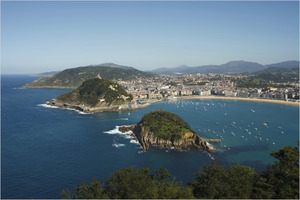 In the morning, I explored the hotel. This included doing what everyone else seemed to do, and having my picture taken sitting beside Alfred Hitchcock. Given his reputation with his leading ladies, I don’t look totally at ease! A very welcoming hotel, with an extensive library of books and DVDs of films which guests can borrow. It would have been good to have the time to make the most of this.
In the morning, I explored the hotel. This included doing what everyone else seemed to do, and having my picture taken sitting beside Alfred Hitchcock. Given his reputation with his leading ladies, I don’t look totally at ease! A very welcoming hotel, with an extensive library of books and DVDs of films which guests can borrow. It would have been good to have the time to make the most of this.
I then took the advice of the receptionist and went by tram to the old part of the city. In the summer, the Office of Tourism runs guided walks but not in the winter months. Despite the weather (still raining), I enjoyed exploring the narrow, winding streets of the old quarter (parte vieja) of this attractive and historic city, known as the treasure of the Basque region. Getting around on foot was easy.
San Sebastian locals are reputed to be extremely fond of their food, so much so that (according to Michael Portillo) the tradition is to eat six meals a day! And, with countless cafes and traditional Basque bars, of course I had to sample the tapas (pinxtos in Basque). While San Sebastian didn’t invent tapas, the Basque people are well acknowledged to have perfected them. I also sampled the speciality drink of the area (called the Kalimotxo – half wine, usually red table wine, and half coca-cola). Interesting.
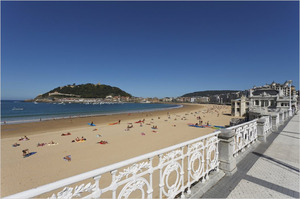 I should have liked to linger longer and, in particular, to walk along the beach (Playa de la Concha) and take the 103 year old funicular to the top of Monte Igueldo for the views. However, the rain had now set in with a vengeance; and I wanted to arrive in Bilbao during daylight hours. I took the tram back to my hotel, picked up my luggage and walked to the Bus Station, where I caught an early afternoon bus to Bilbao. Buses run every half hour between 06.30 and 22.00. No booking was necessary. The journey cost 11.75 euro and took 70 minutes through picturesque scenery. And it stopped raining.
I should have liked to linger longer and, in particular, to walk along the beach (Playa de la Concha) and take the 103 year old funicular to the top of Monte Igueldo for the views. However, the rain had now set in with a vengeance; and I wanted to arrive in Bilbao during daylight hours. I took the tram back to my hotel, picked up my luggage and walked to the Bus Station, where I caught an early afternoon bus to Bilbao. Buses run every half hour between 06.30 and 22.00. No booking was necessary. The journey cost 11.75 euro and took 70 minutes through picturesque scenery. And it stopped raining.
On arrival in Bilbao I walked from the Bus Station to the Miro Hotel. I prefer walking to taking public transport as you see so much more. Crossing Nña Casilda Iturrizar Park, I stopped to have a look at a communal activity area with gadgets etc. being used mainly by older people and chatted with one woman who was exercising there. It struck me as an interesting idea, clearly well used.
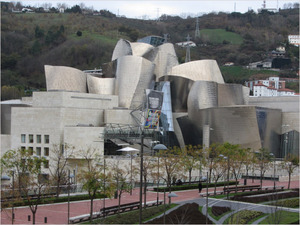 Arriving at the Miro, I immediately felt at home in this small boutique hotel. Decorated by Barcelona fashion designer Antonio Miro, it is ideally positioned opposite the Guggenheim Museum. I was delighted too to be upgraded to a room looking out over the Museum. This is certainly a must see – even if just to marvel at the outside of the building. Frank Gehry designed this titanium-clad twisting, curving and angular building to much praise in the 1990s. The building has a maritime theme, supposedly representing the ships along the docks of the city, with titanium squares acting as fish scales and the skylights inside designed to look like fish fins.
Arriving at the Miro, I immediately felt at home in this small boutique hotel. Decorated by Barcelona fashion designer Antonio Miro, it is ideally positioned opposite the Guggenheim Museum. I was delighted too to be upgraded to a room looking out over the Museum. This is certainly a must see – even if just to marvel at the outside of the building. Frank Gehry designed this titanium-clad twisting, curving and angular building to much praise in the 1990s. The building has a maritime theme, supposedly representing the ships along the docks of the city, with titanium squares acting as fish scales and the skylights inside designed to look like fish fins.
The Museum also offers a natural starting point for a stroll through the Art District, home to the city’s most important art galleries and museums, together with restoration and framing workshops and old book shops. I stopped to speak to a young woman who was working on a tapestry, with one of her finished works on display. As a stitcher myself (one of over a thousand who worked on the Great Tapestry of Scotland), I was really interested in her work, gratified too that she was familiar with ours and how it came about.
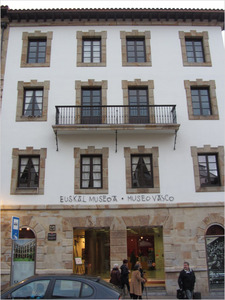 I then decided that the Basque Museum was a must see, and it did not disappoint. Finally, I took some time to wander through the piazzas and the Casco Viejo, admiring the buildings and open air sculptures by contemporary artists, ending with a climb up the Mallona stairs to Parque Etxebarria for beautiful views over the city
I then decided that the Basque Museum was a must see, and it did not disappoint. Finally, I took some time to wander through the piazzas and the Casco Viejo, admiring the buildings and open air sculptures by contemporary artists, ending with a climb up the Mallona stairs to Parque Etxebarria for beautiful views over the city
As dusk fell, I made my way back across the river, gave a few euro to street musicians entertaining passersby, bought some chestnuts and chanced upon an alternative Book Fair below one of the bridges. This was an interesting serendipity find (very busy, with lots of atmosphere, although ‘Health and safety’ would have had a field day with all the trailing cables etc.!). Walking back, the trees lining the roads in the city centre were ablaze with Christmas lights. Back at the hotel, I felt a bit footsore, so I smartened myself up and ate in a nearby restaurant (Serantes): good, if pricey.
Friday Dec 12: Bilbao to Santiago de Compostela (3rd day using Pass)
I was sorry to leave Bilbao and the Miro Hotel. Had I stayed longer, I should certainly have taken advantage of the in-house health suite and massage!
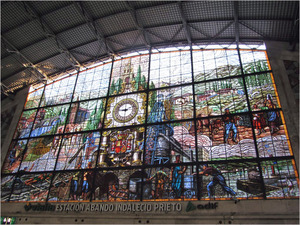 However, 9.00 found me at Bilbao Abando Railway station where I admired its superb stained glass window and bought a snack for the journey. I confess that I wasn’t looking forward to the day. If all had gone according to plan, my travel time would have been approx. 10 hours. As it was, delays added another hour to the journey. I left Bilbao at 09.42 and arrived in Santiago de Compostela at 20.45.
However, 9.00 found me at Bilbao Abando Railway station where I admired its superb stained glass window and bought a snack for the journey. I confess that I wasn’t looking forward to the day. If all had gone according to plan, my travel time would have been approx. 10 hours. As it was, delays added another hour to the journey. I left Bilbao at 09.42 and arrived in Santiago de Compostela at 20.45.
The journey started well: we passed through some beautiful mountain scenery, trees still in Autumn foliage but snow on the mountain tops. Our first hold-up was at Miranda de Ebro, for just over an hour. Two lines converge there. Our small train (only one coach (80 seats: 20 rows with 4 in each, 2 at either side of the aisle) had to wait for another train to arrive and be connected to ours for the onward journey. This did at least allow an opportunity to stretch our legs and have a coffee and a snack in the station. It also broke the ice among the passengers. I got into conversation with a young man from Argentina. He was travelling through Europe for 3 months and was now using a one month Pass which was due to expire in a week. He had travelled through 10 countries, including 27 cities. His favourites were Prague and Paris. He had never been out of Argentina before, never on a plane. He described the trip as ‘life changing’. Swapping travel tales and experiences made the time pass much more quickly and enjoyably than might otherwise have been the case.
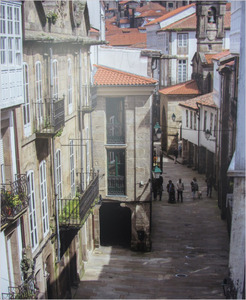 There was another delay at Leon. Shortly after that, a conductor came round and told those of us who were to change at Monforte de Lemos to change coaches right away. Next hold up was at Ourense at 19.15, where our carriage was uncoupled from one engine and recoupled to another.
There was another delay at Leon. Shortly after that, a conductor came round and told those of us who were to change at Monforte de Lemos to change coaches right away. Next hold up was at Ourense at 19.15, where our carriage was uncoupled from one engine and recoupled to another.
My train arrived in Santiago at 20.45, in the pouring rain. Not a taxi to be seen. And very steep stairs to negotiate to reach the town. As the rain was fairly light at that point, I set off to walk to my hotel: Hospederia San Martin Pinario, located just round the corner from the Cathedral. Unfortunately, the heavens opened and I was soaked by the time I got there. Still, the welcome was warm. I was pointed in the direction of a nearby restaurant. And the world looked a whole lot better after a carafe of Rioja.
Note to Readers
Please see the information at the end of Part 1 regarding this ‘test travel’ project.
• Read European travels with a Global InterRail pass – Part 1
• Read European travels with a Global InterRail pass – Part 2
• Read European travels with a Global InterRail pass – Part 4
• Read European travels with a Global InterRail pass – Part 5
• Read European travels with a Global InterRail pass – Part 6
You may also find interesting:
• The Benefits of the InterRail Pass and Top Ten Tips
• InterRailing is for Seniors too!
• Great Train Journeys of the World
• Top Rail Travel Tips
